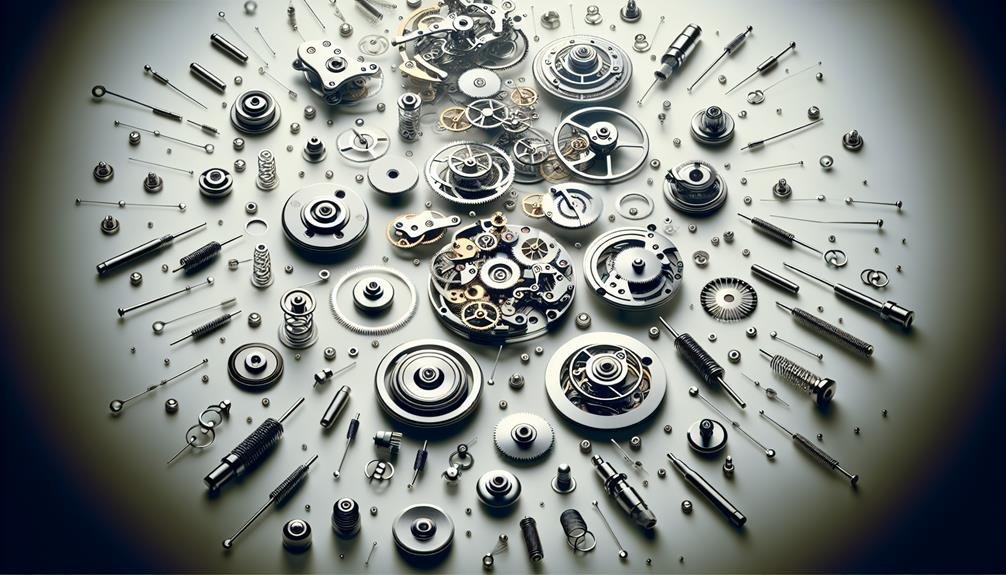Watch movements dictate how your timepiece ticks. They're broadly categorized as mechanical, quartz, automatic, and hybrid. Mechanical movements, powered by a mainspring wound by hand, charm with their captivating aesthetics. Quartz movements, regulated by a tiny quartz crystal subjected to an electric current, impress with their precision. Automatic movements harness energy from your wrist movement, marrying convenience with elegance. Hybrid movements combine quartz's accuracy with the artistry of mechanical movements. Knowledge of and care for these movements extends your watch's lifespan and enhances your horology appreciation. Stick around, there's more intricate horological wonder to unfold.
Understanding Watch Movements

To truly appreciate your timepiece, you need to grasp the intricacies of watch movements – the heart and soul of every watch that dictates its accuracy and functionality. Let's dive into what makes these movements tick.
First, understanding the role of movement manufacturers is essential. They're the masterminds behind the precision of your watch. They painstakingly design and assemble each component, ensuring they synchronize to keep accurate time. Renowned brands like Seiko, Rolex, and Patek Philippe aren't just known for their design, but also for their in-house movements that set them apart in the horological world.
Next, consider the movement aesthetics. While it's the inner workings that make your watch accurate, it's the aesthetics that make it a piece of art. You've probably admired a watch for its beautiful design without realizing the artistry beneath the surface. Movement aesthetics involve the arrangement and finishing of components, visible through a transparent case back or skeleton dial. The beauty of a well-crafted movement can be as captivating as the timepiece's external design.
The Role of Watch Movements

When you glance at your watch to check the time, you're relying on the essential role of the watch movement, often unseen but always hard at work. This intricate mechanism is the heart of every timepiece, controlling the hands' movement and powering any additional features like chronographs or calendars.
The Movement Manufacturing process is a marvel of precision engineering. It's a delicate assembly of gears, springs and tiny components that work in perfect harmony. The level of craftsmanship that goes into these mechanisms is a testament to the watchmaker's artistry and skill.
Now, let's talk about Movement Lifespan. With proper care, a quality watch movement can last for many years, even generations. It's not just about keeping time; it's about enduring time. Regular maintenance, including cleaning and lubrication, can prolong the movement's life, maintaining its accuracy and reliability.
Dive Into Mechanical Movements
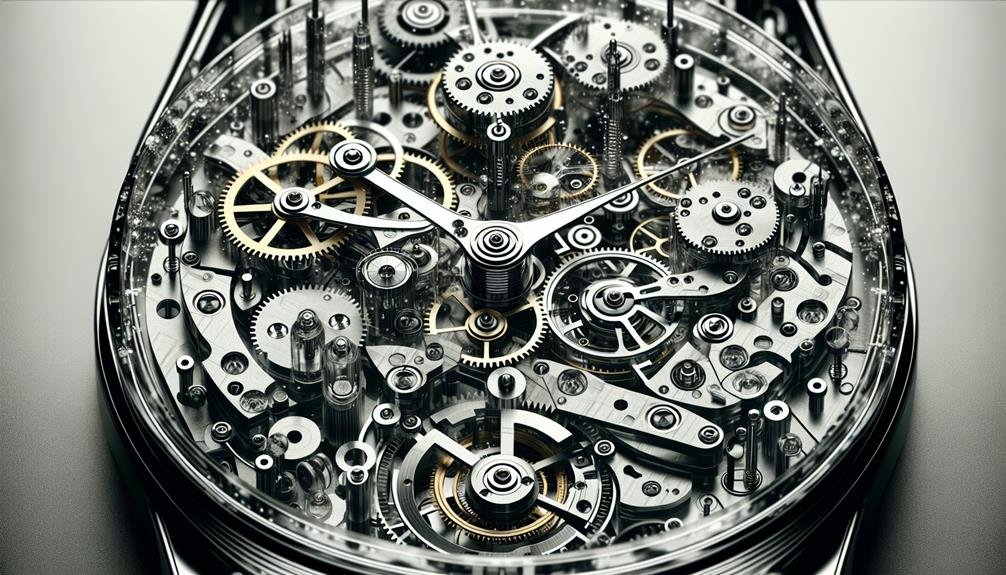
Now that we've covered the role and lifespan of watch movements, let's get our gears turning with the fascinating world of mechanical movements. Mechanical movements are the heart and soul of traditional horology. They're all about movement aesthetics and innovation, a marriage of form and function that's nothing short of captivating.
Mechanical movements are powered by a mainspring, which is wound manually or automatically. As it unwinds, it releases energy that drives the watch hands. All of this takes place within the watch's movement, a complex assembly of gears, springs, and wheels. The intricate design and the precision of its operation make mechanical movements a marvel to behold.
Movement aesthetics in mechanical watches are truly a sight to behold. The intricate parts working in harmony often visible through a transparent case back, are mesmerizing. It's a testament to the skill and artistry of watchmakers, and it's also why mechanical watches often command a premium price.
Movement innovation is another aspect that keeps mechanical watches relevant. Despite the rise of quartz and digital watches, horologists continually innovate, improving accuracy, efficiency, and durability of mechanical movements. It's an ever-evolving field, and that's what makes it so exciting.
The Intricacies of Quartz Movements
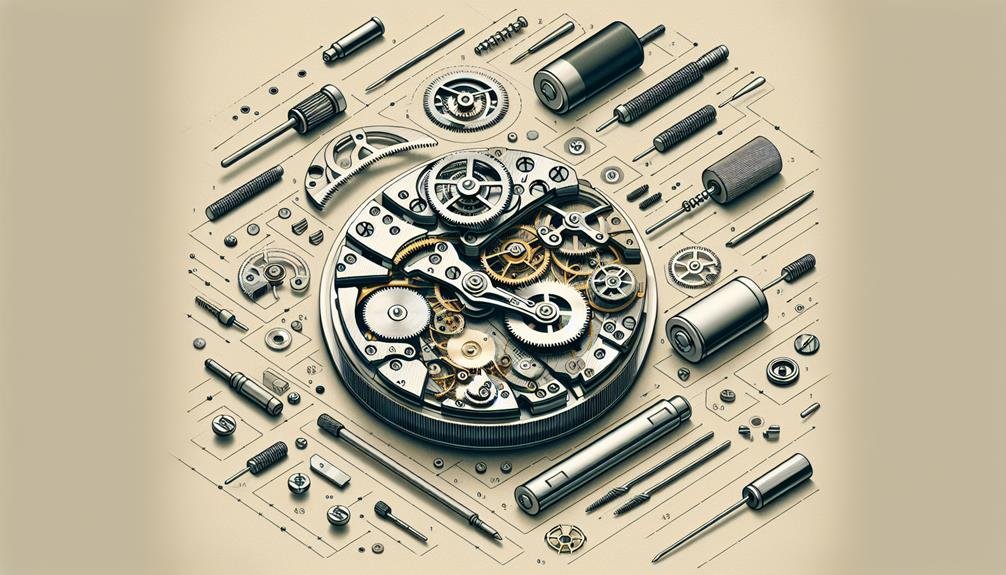
Delving into the world of quartz movements, you'll discover a realm where precision and convenience reign supreme. This technology, powered by a tiny quartz crystal, has revolutionized the watch industry with its impressive accuracy. When voltage is applied, the crystal oscillates at a constant frequency, resulting in precise timekeeping. In a precision comparison with other types, quartz wins hands down.
Beyond precision, quartz movements offer notable advantages in sustainability. Unlike mechanical movements, quartz watches don't require winding, reducing wear and tear on parts. They're also more resistant to shocks and impacts, adding to their longevity. You'll appreciate quartz sustainability when your watch keeps ticking, even after years of use.
But it's not just about durability. Quartz movements are also more energy-efficient. They use less power, which means fewer battery replacements, contributing to a smaller ecological footprint. Plus, the reduced complexity of quartz movements makes them easier to manufacture and repair, which can lower costs for you.
However, quartz watches aren't without their critics. Some purists argue that they lack the craftsmanship and soul of mechanical watches. But for those who value precision, convenience, and sustainability, quartz movements are hard to beat.
Exploring Automatic Watch Movements
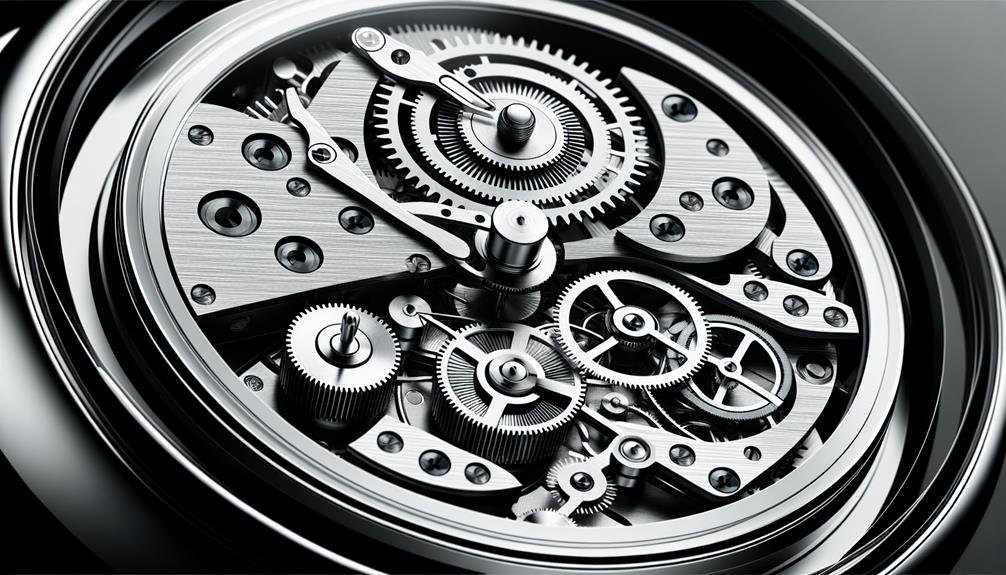
Diving into the realm of automatic watch movements, you'll find yourself immersed in a world where traditional craftsmanship meets modern technology. Let's delve into the automatic mechanism history to truly appreciate their evolution.
Born in the late 18th century, the automatic watch movement, also known as self-winding, marked a significant milestone in horology. It revolutionized the industry, eliminating the need for daily winding by harnessing the energy from the wearer's wrist movements. From Abraham-Louis Perrelet's pioneering work to Rolex's contemporary 'Perpetual' movement, this ingenious system has continually evolved.
Now, let's talk about movement efficiency analysis. The efficiency of an automatic watch movement rests heavily on its power reserve capacity and the precision of its timekeeping mechanism. The more advanced the movement, the longer it holds power, and the more accurate it is. So you'll find that high-end watches typically boast sophisticated movements, delivering supreme accuracy and longevity.
In essence, automatic watch movements are a testament to human ingenuity. They offer convenience, precision, and a beautiful rhythm of mechanics that's both functional and mesmerizing to behold. Remember, understanding its workings enhances your appreciation of this intricate timepiece on your wrist.
Hybrid Movements Explained
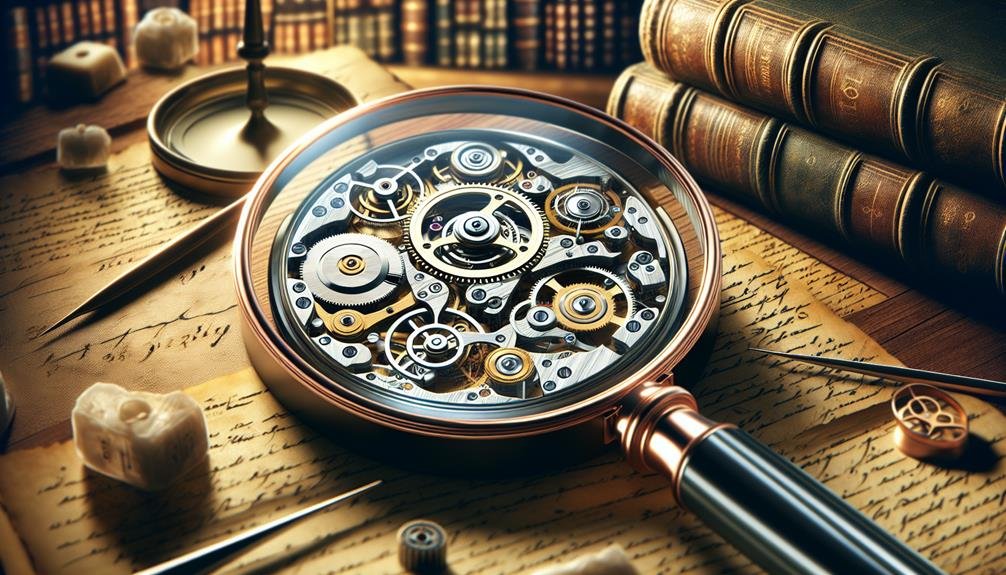
Stepping into the world of hybrid movements, you'll uncover a fascinating blend of mechanical and quartz technology that pushes the boundaries of watchmaking innovation. These movements synergize the best of both worlds, combining the accuracy of quartz with the charm of mechanical components.
Let's talk about hybrid movement advantages. You'll appreciate the quartz component's precision, which trumps purely mechanical movements. It ensures your watch keeps time accurately, eliminating the need to frequently adjust it. The mechanical aspect, on the other hand, adds a touch of traditional watchmaking artistry. It's a visual delight, especially for watch enthusiasts who love glimpsing the intricate workings of gears and springs.
However, hybrid movement challenges are worth considering. While they offer the best of both worlds, hybrid movements also inherit the drawbacks of both. The mechanical part requires regular maintenance, which can be costly and time-consuming. Meanwhile, the quartz part, powered by a battery, demands regular replacement.
Ultimately, it's the combination of these two technologies, each with its own strengths and weaknesses, that makes hybrid movements a unique and innovative choice in the world of horology.
Comparing Different Watch Movements

Now that you're familiar with the intricacies of hybrid movements, let's start comparing different watch movements to help you understand their unique features and benefits. When evaluating watch movements, two essential factors to consider are movement longevity and movement craftsmanship.
Mechanical movements, for example, are often lauded for their longevity. With regular servicing, they can last for decades, even centuries, becoming cherished heirlooms passed down through generations. In contrast, quartz movements, while more accurate, typically have a shorter lifespan due to their reliance on electrical components and batteries.
In terms of craftsmanship, mechanical movements again tend to shine. They're meticulously assembled by skilled watchmakers, often featuring intricate designs and complications. Quartz movements, on the other hand, are usually mass-produced, lacking the same level of artistry. However, they offer reliability and precision, which you might prioritize over aesthetic appeal.
Hybrid movements attempt to blend the best of both worlds, offering the reliability and accuracy of quartz with the craftsmanship and longevity of mechanical movements. However, they're often more complex and costly as a result.
Caring for Your Watch Movement
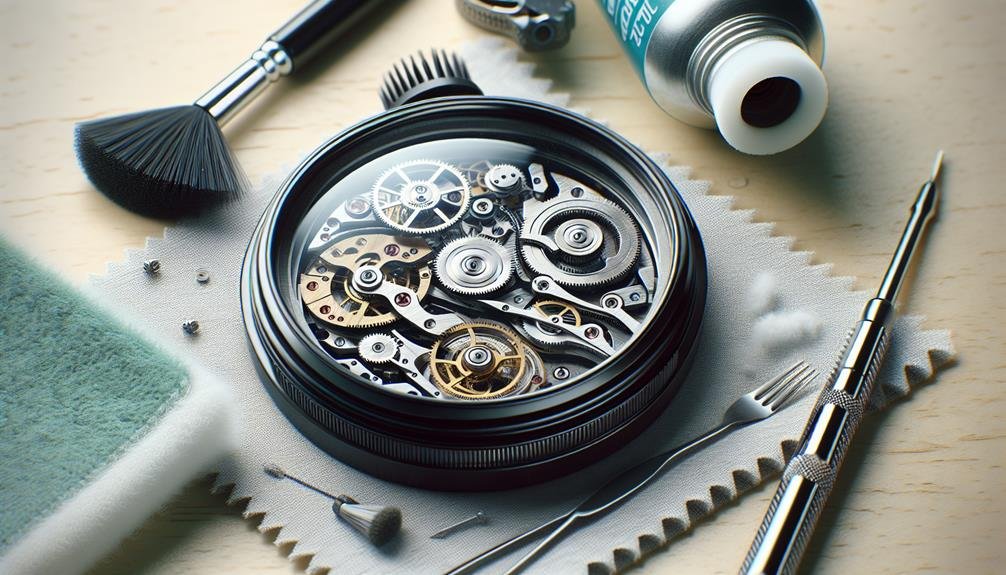
Proper care and maintenance of your watch movement can significantly extend its life and maintain its accuracy. Keeping the inner workings of your timepiece in top shape isn't as complex as you might think.
Start with regular movement maintenance. This requires professional check-ups every three to five years. Don't try to disassemble the watch yourself; a trained watchmaker should handle this delicate task. They'll clean, oil, and adjust the movement, ensuring it continues to function flawlessly.
Next, consider your watch's environment. Extreme temperatures and moisture can shorten a movement's lifespan. Avoid exposing your watch to these conditions. Also, remember to take off your timepiece before engaging in activities that might cause shocks or vibrations.
Conclusion
So, you've dived into the world of watch movements, exploring everything from mechanical to quartz, automatic, and even hybrid movements.
You now understand their role and intricacies, and how to care for them.
Remember, your watch's movement isn't just about keeping time; it's the heart of your timepiece.
Cherish it, understand it, and you'll deepen your appreciation for the craftsmanship that goes into every tick and tock of your watch.
